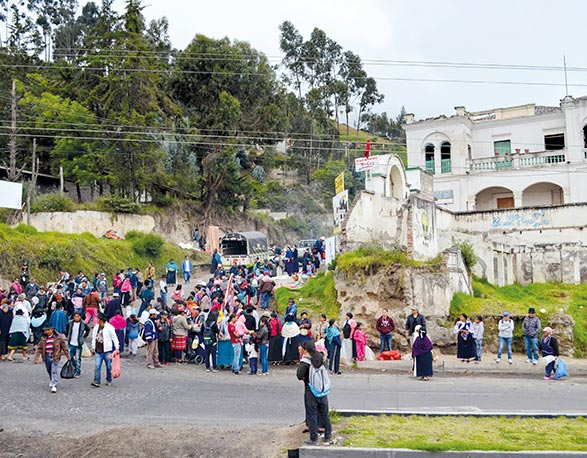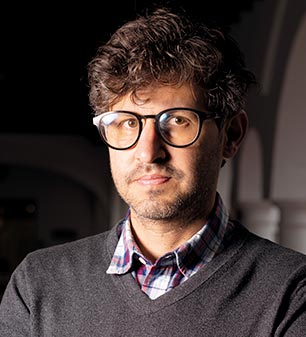Ecuador: from an invisible state to an influential country in the region
By: Inés Elvira Ospina Echandía
Photos:
Economics and Politics

By: Inés Elvira Ospina Echandía
Photos:
Renewing their identity from time to time has been a constant characteristic of Latin American countries. With this continuous change, they seek to overcome their weaknesses and improve their strengths. Generally, these governments do not act because they want to, but because they are forced to change, to transform their institutions, and to propose a new political, social, economic, and cultural order.
History has proved this. Because of the social movements, especially those promoted by the young, that emerge due to a lack of representation in State policies, parties, or institutions and that clamor for substantial and not cosmetic changes, these identity transformations take place, leading to a refoundation. This is how Mauricio Jaramillo Jassir, a professor at the Faculty of International, Political, and Urban Studies at Universidad del Rosario, explains it and sets examples such as the 1991 Constitution in Colombia, following the movement known as Séptima Papeleta, or the constitution in Venezuela, or the Bolivarian revolution in 1999.
Jaramillo explored how these refoundations impact the foreign relations of marginal countries, i.e., third world or developing countries. The expert claims that “they may be defined as the countries considered irrelevant owing to their little historical influence and because they are far from the ‘core’ of the decision-making process.”
He considered Ecuador because it had a State refoundation in the “short term.” “The article is an appetizer helping people understand all the changes that Ecuador has endured in relation to its identity and how all of these have influenced its foreign policy, especially during Rafael Correa’s government,” he argues.
The hypothesis posed by Foreign Policy and Marginal States. Analysis of Ecuador’s Identity Transformation explains that, between 2008 and 2011, the neighboring country transformed its identity to influence certain regional topics, without lining up with other States and reducing the perceived vulnerabilities.
The professor’s interest in Ecuador emerged in 2011 while he was writing on the relationship between populism and democracy in this South American country as a part of his doctoral thesis. Then, in 2015, working as an Advisor to the Secretary General of the Union of South American Nations (USAN), he tried to go deeper into the relationship between internal transformation and foreign policy, considering the lack of documents on the international relations of marginal countries, such as Ecuador.
These activities in USAN allowed Professor Jaramillo to witness the manipulation of public policies by high ranking authorities, not only in connection to the international relations of the national and regional interest but also in other areas, such as the economy. This helped him to understand and analyze the situations that he could not find in the documents.
In addition to this privileged information, he utilized the media coverage of this topic. “It was important to analyze how foreign media view Ecuador,” explains the researcher. “For instance, March 2008 marks a milestone in Colombia because Raul Reyes Camp was attacked on this date. According to some sources, prior to that day, the Colombians considered Ecuador as a developing country, with even some traces of racism; after that date, however, the local press got interested and analyzed the situation there. In fact, from this date on, they have covered every presidential election.”
To support this argument, the researcher reviewed different headlines from the mainstream media in both countries. Between 2008 and 2011, he kept track of the news in both countries in terms of politics, public order, and specifically all statements made by the then presidents Álvaro Uribe and Rafael Correa. He also reviewed the scarce specialized literature on the foreign policies of some marginal countries in Latin America.
He claims that the information about the foreign policies of Colombia, Argentina, Brazil, and Mexico is plentiful, yet there is little information about countries such as Uruguay, Paraguay, or Ecuador. This void convinced him further to document the topic.
Ecuador, a change with history
Jaramillo divides his work in three stages. In the first one, he analyzes the State refoundation that Ecuador endured from the late nineties to the presidential government of Rafael Correa, mainly between 2008 and 2011. Second, he addresses the way in which this new identity influences foreign policy. Finally, the third stage outlines some ideas to interpret the Ecuadorian change of identity

These activities in USAN allowed professor Mauricio Jaramillo Jassir to witness the manipulation of public policies by high-ranking authorities.
The short period in which these internal refoundation changes developed, and that are generally associated with the former president Rafael Correa but go some decades back, was what caught the professor’s attention. His investigation demonstrated that this process had been developing for some time, without being established. The 1990 Indigenous Uprising marked its origin. “The Columbus Quincentenaries’ caused indigenous uprisings because of what it meant for the Ecuadorians, the arrival of the Spanish regime and culture. In Ecuador, precisely between 1990 and 1992, the movement rejected the Spanish legacy. It called for recognition and increased autonomy to handle their own business,” explains Jaramillo.
Several protests from independent social sectors that were not being represented by the political parties, explains the professor, joined the native communities. This nonconformity ended in 1997 with the dismissal of the then president, Abdalá Bucaram, and the creation of a new constitution. Several changes were made such as acknowledging Ecuador as a multicultural State, updating the political systems, the separation of powers, and, in general, a text in harmony with the democratic ideas of the time because the previous constitution had been established in the military period
These transformations, however, could not be reflected. The country suffered from its worst economic crisis in 1999, which led to the dollarization and the end of the sucre. It was a result of international phenomena such as the housing bubble outbreak in South Asia, the drop in oil barrel prices, and the natural disasters caused by El Niño toward the end of the year and the Tungurahua Volcano. Jaramillo believes that the combination of these events led to a “revolution of citizens,” that allowed Ecuador to reborn abroad, taking advantage of the high levels of internal cohesion caused by the authoritarian government of Rafael Correa, as explained by most people. In 2008, the constitution was reformed again and Ecuador stopped being an irrelevant State in the area and transformed into a leader, not enough influential though, that gained visibility in relation to certain topics.
Correa’s government generated consensus, overcame internal blocks, and took the first steps toward economic recovery, giving shape to the refoundation. This change, however, was not the result of a presidential decision, or a shift in discourse; rather, it was related to how Ecuador built its narrative and how the rest of the world received it,” explains Jaramillo.
The professor claims that one of the clearest examples of such changes in foreign policy can be seen in the transformation of diplomatic relations with Colombia. Under the motto “Ecuador loves life,” the neighboring country sued Colombia before the world court at The Hague for the aerial spraying of glyphosate over the border. For the first time in a long time, Quito prevailed over Bogotá in the conciliation in which Colombia preferred to pay 15 million dollars to Ecuador to prevent the court from passing a strict sentence.
Furthermore, in 2008, both countries broke off diplomatic relations after the attack on Raul Reyes Camp, who was the FARC second in command, in the Ecuadorian city of Santa Rosa de Sucumbíos. In March, the Ecuadorian government decided to sue Colombia before the International Court of Justice for the death of Franklin Aisalla, a civilian who died in the attack.
The researcher claims that these events produced a change in the regional perception of Ecuador: it dropped its image of an extremely vulnerable country, marked by the defective border agreement signed with Peru in the Presidential Act of Brasilia in 1998 and the constant attacks from Colombia in the fight against the guerrillas, and obtained a political and pecuniary compensation.
Thus, Ecuador adopted the identity of an actor who is able to fight against all regional hegemonies with the law. In addition to judicial aspects, it also took a stand in other fields, such as the environment. The idea of imposing its image of a State that “loves life” was tightly connected to the condition of the Amazonian country and the attacks it suffered from its northern neighbor.
“In Colombia, this generated a reductionist view of what is known as ‘the turn to the left’ in Latin America. Often, Colombians view this presence with fear, caution, prevention, and even exaggeration. This extended toward the collective imagination of Ecuador: it was seen as a bad copy of Venezuela,” states Jaramillo. “Nevertheless, time has proven that they are very different cases. Ecuador succeeded in many aspects in which Venezuela failed: its foreign policy and a more viable economic model.”
Ecuador adopted the identity of an actor who is able to fight against all regional hegemonies with the law. In addition to judicial aspects, it also took a stand in other fields, such as the environment.
At the beginning of the investigation, Jaramillo thought that there was a strong relationship between foreign policy and the refoundation of states. The analysis of the Ecuadorian case, however, showed him another reality: internal changes remain overtime, but not foreign policy. “With the results, I could conclude that the internal structural refoundation of Ecuador was irreversible, but the changes introduced by Correa in the matter of foreign policy were more relevant,” adds Jaramillo.
The short period of time in which all these changes took place was another aspect that shocked the researcher. Even within a period of 10 years, considerable transformations such as the security doctrine and the perception of Ecuadorians about being part of a visible country with its own identity, developed in almost four or five years. Likewise, the third-party perception of the country also changed: Ecuador went from being an invisible State to an influential one, leading on issues such as USAN, for instance.
Another conclusion highlighted by the researcher is how states can modify their foreign policy in the face of sensitive matters such as the national security agenda. Jaramillo evinced that up to 1998, Ecuador’s main “enemy” or “geopolitical rival” was Peru, because they share a history of war, conflicts, and disagreements. However, the modification in the foreign agenda led the country to have new “rivals.”
This same analysis, points out the professor, could be extended toward other Latin American countries because many of them have been transformed over the last five years, deriving from both internal and external modifications. “It is possible to analyze, for example, the refoundation of Bolivia and Colombia. Both led to changes in their foreign policies,” he concludes.